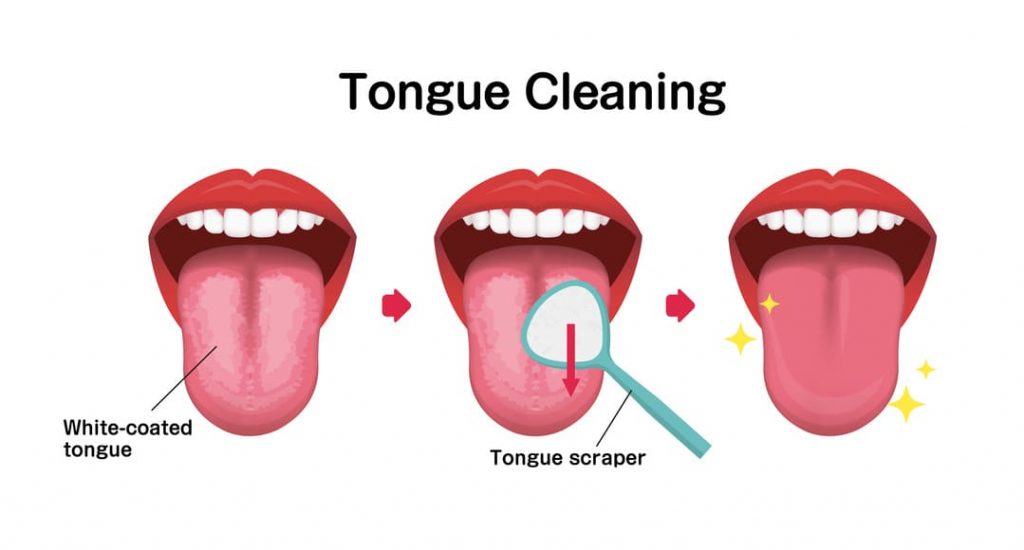What is Halitosis (Bad Breath)?
Halitosis or bad breath is a malodor or unpleasant smell of breath beyond social acceptance. It not only leads to social embarrassment but can also cause harm to your oral health, depending on whether it is non-pathologic or pathologic in origin.
“1 in every 4 individuals is affected by bad breath or halitosis.”
Different studies show different results. Considering one study on PubMed that considered many different articles to reach a conclusion it shows a 31.8% prevalence.
Bad breath in halitosis is usually caused by bacterial putrefaction of food debris, protein, and peptides in saliva, gingival crevicular fluid, and plaque, which forms volatile sulfur substances like hydrogen sulfide and methyl mercaptan.
Types of bacteria involved in
Responsible gram-negative bacteria: Prevotella intermedia, Prevotella nigrescens, Aggregatibacter actinomycetemcomitans, Campylobacter rectus, Fusobacterium nucleatum, Peptostreptococcus micros, Porphyromonas gingivalis, Tannerella forsythia, and spirochetes.
Responsible gram-positive bacteria: Streptococcus salivarius, Solobacterium moorei.
Types and Causes of Halitosis or Bad Breath
Mostly halitosis can be divided into two main categories:
1. Transient halitosis
- Transient which can also be called temporary halitosis. This is usually caused by bad oral hygiene or after consuming strong odor-causing food.
- Factors such as bad breath in the morning, food items such as garlic and onion, and smoking can also cause this.
- This type of halitosis can be cured by maintaining proper oral hygiene, such as daily brushing, flossing, and mouthwash.
2. Chronic halitosis
This type of halitosis lasts for a more extended period and cannot be resolved even after maintaining good oral hygiene. There can be many factors that could cause this and that can be put under different subcategories,
Oral Halitosis
This type is usually associated with,
A. Poor oral hygiene: It is a common cause of halitosis. It increases bacterial growth in the mouth and causes bad breath. The tongue coating is the most common cause of poor oral hygiene. The rough Tongue surface (specifically the dorsal posterior surface) provides room for bacteria growth and food debris, and it remains an escape from normal oral hygiene if not properly cleaned. It causes the formation of a coating on the tongue which is the responsible factor in most cases of bad breath or halitosis.
B. Periodontal disease (gum disease): Certain periodontal diseases like Acute necrotizing ulcerative gingivitis and chronic periodontitis.
C. Pericoronitis: This is the condition of gum inflammation surrounding a partially erupted tooth, most commonly surrounding a wisdom tooth. This forms small pockets that trap the food, hard to clean. Which in turn causes bad breath.
D. Dry socket (also known as Alveolar osteitis): It can be seen in conditions like Dry socket. Read more about the Dry socket.
E. Dry mouth (xerostomia): This condition occurs in patients with decreased salivary flow. Saliva plays an important role in cleaning food particles and bacteria in the mouth. Decreased levels of saliva can result in increased levels of bacteria in the mouth, which in turn causes bad breath.
Systemic and medication-induced halitosis
Systemic, as the name suggests, is caused by any underlying medical condition other than oral origin. These medical conditions usually produce compounds with foul odors released while exhaling and breathing. The conditions include,
A. Respiratory, Lungs, and bronchial infections: Infections like bronchitis, pneumonia, pulmonary abscess, lung cancer, and bronchiectasis may develop a bad odor in breathing.
B. Tonsils: Tonsils are present on the backside of the oral cavity which can trap the food and after a certain period the trapped food gets calcified and causes bad breath.
C. Gastrointestinal disorders: such as acid reflux or liver disease.
D. Diabetes: In diabetes mellitus, the accumulation of ketones causes sweet fruity-smelling breath.
E. Kidney disease: In cases of chronic glomerulonephritis, increased dimethylamine and trimethylamine cause a fishy odor of the breath.
F. Metabolic disorders
G. Hormonal changes: In the menstrual cycle, precisely a day around ovulation, volatile sulfur substances increase in the breath, causing odor in the breath.
H. Medication-induced halitosis: specific medications cause dry mouth (xerostomia) as a side effect of taking that drug. This will result in all the problems mentioned in the dry mouth segment above. Medication includes classes of drugs such as:
- Antidepressants
- Antihistamines
- Decongestants
- Antipsychotics
- Antihypertensive medications
- Anticholinergic drugs
- Medications for Parkinson’s disease
3. Psychological Halitosis or delusional halitosis
This is a condition in which a person believes they have bad breath, but they don’t have it. Even after getting assurance from the dentist, their friends, and family that their breath is normal still they don’t believe that.
How do I know if I have Bad breath?
How do I diagnose what type of bad breath I have?
Consulting with a dentist is the best way to diagnose halitosis. If you have bad breath that does not resolve for many days even after maintaining good oral hygiene, this is an indicator to see your dentist as soon as possible. Because this type of chronic bad breath can be a sign of an underlying medical condition.
Usually, dentists can determine the root cause of halitosis and guide you through the best possible treatment.
Treatment of Halitosis or Bad Breath
Treatment depends on the type of halitosis. The best treatment for halitosis is targeting the contributing factor of the disease that is causing the disease. Having said that, there is no single treatment that works for halitosis; treatment depends on the root cause of the disease. Various treatments can be considered:
Maintain Good Oral Hygiene
1. Tongue scraper: Good oral hygiene is an important key factor for preventing many oral diseases and also treating halitosis or bad breath. The tongue coating (which contains bacteria and food debris) is the major cause of bad breath or halitosis, which is why it is important to clean the tongue with a tongue scraper to remove the coating. Scraping the posterior tongue, where there is the highest chance of bacterial growth, is especially important. Initially, it may be difficult because of the gag reflex, but gradually, you become habituated.

2. Regular brushing: Regular brushing (twice a day) with a soft-bristle brush, and brush gently over the tongue.
3. Mouthwash: Mouthwash can be used to cure halitosis. Consult with a dentist for the best mouthwash for you.
4. Flossing: cleaning between the teeth is very important.
Related: 10 Ways to Keep Your Teeth Healthy
Treat Dry mouth
Try to stay hydrated throughout the day. More importantly, consult a dentist to determine the root cause of dry mouth.
Treat existing diseases that cause terrible breath
Oral diseases like acute necrotizing ulcerative gingivitis, chronic periodontitis, pericoronitis, dry mouth, dry socket, etc. Visit your dentist to find and treat such a disease.
Masking Malodor/Bad Breath
This is a temporary solution to mask bad breath using pleasant-smelling sprays, lozenges, and mouth rinses. It doesn’t remove the causative factor but temporarily masks bad breath.
Visit your dentist if you are suffering from bad breath to find out the actual cause of it to treat it well. Sometimes, bad breath occurs due to systemic diseases or conditions, so it is essential to consult your dentist.
Frequently asked questions
Q.1 Which is the Best Mouthwash for Bad breath?
Selecting the type of mouthwash depends on the underlying cause of bad breath. Below are some types of mouthwash that can be used depending on the cause:
- Antibacterial mouthwash: This mouthwash usually contains chlorhexidine, cetylpyridinium chloride, or essential oils like eucalyptol, menthol, thymol, and methyl salicylate. Combined, This helps reduce the bacteria in the mouth and can also cure gum disease.
- Alcohol-free mouthwash: This type of mouthwash is considered the most gentle on the oral tissue. A person with a dry mouth or sensitive tissue can use it. It is safe for many patients as it is the least irritating.
- Oxygenating mouthwash: contains compounds such as hydrogen peroxide, an oxygen-releasing compound. This helps inhibit the bacteria that produce sulfur, which usually causes a bad odor.
- PH-balanced mouthwash: this mouthwash helps maintain a neutral pH of the mouth, which is the ideal environment to reduce odor-producing bacterial growth.
When deciding to choose mouthwash, it is essential to know the type of halitosis. Consulting with a dentist is the best way to select a mouthwash, as they can recommend the best according to the type of bad breath.
Q.2 Which is the Best way to use toothpaste for Bad breath?
Again, it all depends on the type of bad breath. However, there are some characteristics to consider before buying toothpaste, such as tartar control, fluoride content, antibacterial properties, and gentle formulation (for sensitive tissue). Consult with the dentist for better results.
Q.3 Does chewing gum prevent bad breath, and what is the best gum for Bad breath?
Gums can temporarily give you fresh breath, but they are not a permanent solution for bad breath. Gums can temporarily increase salivary flow, which helps clean the bacteria in your mouth.
Things to be considered before buying gums:
- For gums with an ADA seal of acceptance that proves the safety.
- Needs to be sugar-free gum.
- Xylitol content: Xylitol replaces sugar as a sweetener and has shown some sign of inhibiting bacteria that causes tooth decay and bad breath.

